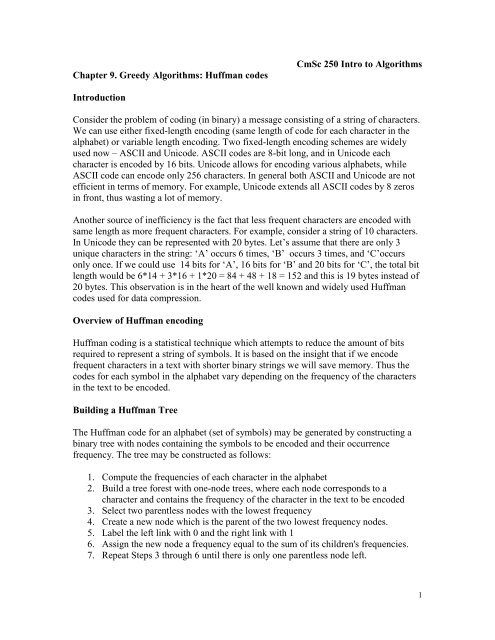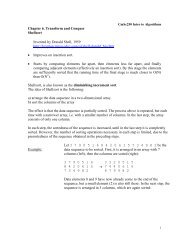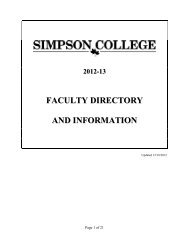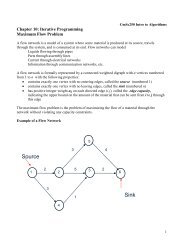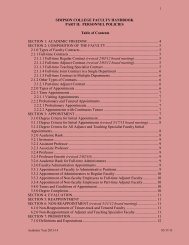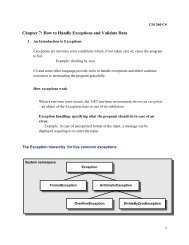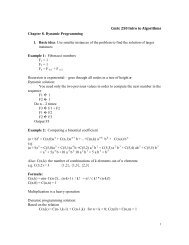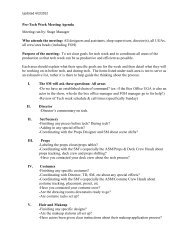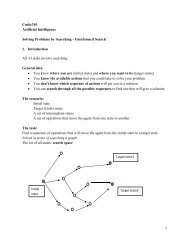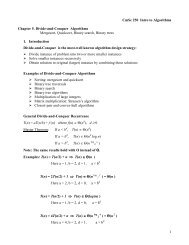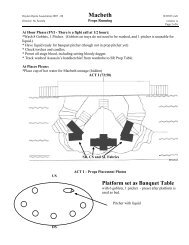Create successful ePaper yourself
Turn your PDF publications into a flip-book with our unique Google optimized e-Paper software.
Chapter 9. Greedy Algorithms: <strong>Huffman</strong> codes<br />
CmSc 250 Intro to Algorithms<br />
Introduction<br />
Consider the problem of coding (in binary) a message consisting of a string of characters.<br />
We can use either fixed-length encoding (same length of code for each character in the<br />
alphabet) or variable length encoding. Two fixed-length encoding schemes are widely<br />
used now – ASCII and Unicode. ASCII codes are 8-bit long, and in Unicode each<br />
character is encoded by 16 bits. Unicode allows for encoding various alphabets, while<br />
ASCII code can encode only 256 characters. In general both ASCII and Unicode are not<br />
efficient in terms of memory. For example, Unicode extends all ASCII codes by 8 zeros<br />
in front, thus wasting a lot of memory.<br />
Another source of inefficiency is the fact that less frequent characters are encoded with<br />
same length as more frequent characters. For example, consider a string of 10 characters.<br />
In Unicode they can be represented with 20 bytes. Let‟s assume that there are only 3<br />
unique characters in the string: „A‟ occurs 6 times, „B‟ occurs 3 times, and „C‟occurs<br />
only once. If we could use 14 bits for „A‟, 16 bits for „B‟ and 20 bits for „C‟, the total bit<br />
length would be 6*14 + 3*16 + 1*20 = 84 + 48 + 18 = 152 and this is 19 bytes instead of<br />
20 bytes. This observation is in the heart of the well known and widely used <strong>Huffman</strong><br />
codes used for data compression.<br />
Overview of <strong>Huffman</strong> encoding<br />
<strong>Huffman</strong> coding is a statistical technique which attempts to reduce the amount of bits<br />
required to represent a string of symbols. It is based on the insight that if we encode<br />
frequent characters in a text with shorter binary strings we will save memory. Thus the<br />
codes for each symbol in the alphabet vary depending on the frequency of the characters<br />
in the text to be encoded.<br />
Building a <strong>Huffman</strong> Tree<br />
The <strong>Huffman</strong> code for an alphabet (set of symbols) may be generated by constructing a<br />
binary tree with nodes containing the symbols to be encoded and their occurrence<br />
frequency. The tree may be constructed as follows:<br />
1. Compute the frequencies of each character in the alphabet<br />
2. Build a tree forest with one-node trees, where each node corresponds to a<br />
character and contains the frequency of the character in the text to be encoded<br />
3. Select two parentless nodes with the lowest frequency<br />
4. Create a new node which is the parent of the two lowest frequency nodes.<br />
5. Label the left link with 0 and the right link with 1<br />
6. Assign the new node a frequency equal to the sum of its children's frequencies.<br />
7. Repeat Steps 3 through 6 until there is only one parentless node left.<br />
1
Here is a simple example. Text: “here is a simple example”<br />
Letters with their frequency:<br />
_ (space) 4 M 2<br />
A 2 P 2<br />
E 5 R 1<br />
H 1 S 2<br />
I 2 X 1<br />
L 2<br />
In the Figure below, the red links are labeled with “0” and the blue links are labeled with<br />
“1”. The colored nodes are the initial one-node trees.<br />
24<br />
15<br />
9<br />
7 8<br />
_/4 E/5<br />
3<br />
4<br />
4 4<br />
2<br />
X/1<br />
A/2 I/2<br />
L/2 M/2 P/2 S/2<br />
H/1<br />
R/1<br />
The code for each symbol may be obtained by tracing a path from the root of the tree to<br />
that symbol.<br />
2
_ (space) 10 M 0101<br />
A 0010 P 0110<br />
E 11 R 00001<br />
H 00000 S 0111<br />
I 0011 X 0001<br />
L 0100<br />
Symbols with higher frequency will be included later in the tree and therefore will be<br />
closer to the root – this means shorter code.<br />
Implementation<br />
There are various implementations of the algorithm. One implementation is given below:<br />
Let N be the number of the characters in the alphabet<br />
Data structures need:<br />
Array frequencies[0...2N] : represents node frequencies.<br />
The first N elements represent the frequencies of the alphabet characters.<br />
if frequencies[k] > 0, 0 k N-1, then frequencies[k] is a terminal node<br />
representing the k-th character<br />
Array parents[0..2N] : represents the parents of each node in array frequencies.<br />
The parent of node k with frequency frequencies[k] is given by abs(parents[k]).<br />
If parents[k] > 0, node k is linked to the left of its parent, otherwise – to the right.<br />
Priority queue with elements (k, frequencies[k]), where the priority is represented by<br />
frequencies[k].<br />
1. For each character at position k in the alphabet compute frequencies[k] and insert<br />
in a priority queue if frequencies[k] > 0<br />
2. m N<br />
3. while PQueue not empty do<br />
a. deleteMin from PQueue (node1, frequency1)<br />
b. if PQueue empty break<br />
c. else deleteMin from PQueue (node2, frequency2)<br />
d. frequencies[m] frequency1 + frequency2 // new node<br />
e. parents[node1] m // left link<br />
f. parents[node2] -m // right link<br />
g. insert in PQueue (m, frequency1 + frequency2)<br />
h. m m + 1<br />
4. end // tree is built with root = node1<br />
3
To encode a character<br />
Start with the leaf corresponding to that character and follow the path to the root<br />
The labels on the links in the path will give the reversed code.<br />
code “”<br />
while k not equal to the root do<br />
if parent[k] > 0 code = “0” + code<br />
else code = “1” + code<br />
k parents[k]<br />
if k < 0 k -k<br />
To restore the encoded text<br />
Start with the root and follow the path that matches the bits in the encoded text, i.e. go<br />
left if „0‟, go right if „1‟.<br />
Output the character found in the leaf at the end of the path.<br />
Repeat for the remaining bits in the encoded text<br />
p 0<br />
while p encodedTextSize<br />
k root<br />
while k > N-1 do<br />
if encodedText[p] is 0 find parents[m] so that parents[m] = k<br />
if encodedText[p] is 1 find parents[m] so that parents[m] = -k<br />
k m, p p+1<br />
output alphabet[k]<br />
After the inner loop k will point to the encoded character in the alphabet.<br />
Analysis of the algorithm to create the <strong>Huffman</strong> tree for an alphabet with length N:<br />
O(NlogN)<br />
The insert and delete operations each take log(N) time, and they are repeated at most<br />
2N times (Why 2N ? Answer: The leaves are N, therefore the nodes are less than 2N)<br />
Therefore the run time is O(2NlogN) = O(NlogN)<br />
4
Discussion and Summary<br />
<br />
<br />
<br />
<strong>Huffman</strong> trees give prefix-free codes. Prefix-free codes have the property that no<br />
code is a prefix of any other code. This allows to avoid using a delimiter to<br />
separate the codes of the individual characters.<br />
<strong>Huffman</strong> trees are full trees – i.e. each node except the leaves has two children.<br />
The length of the encoded message is equal to the weighted external path length<br />
of the <strong>Huffman</strong> frequency tree.<br />
Definition Let T be a tree with weights w 1 ,...w n at its leaf nodes. The weighted leaf path<br />
length L(T) of T is defined as the sum<br />
L(T) = l i w i<br />
i leaf(T)<br />
where leaf(T) is the set of all leaves of T, and l i is the path length - the length of the path<br />
from the root to node i.<br />
In fact, <strong>Huffman</strong> codes solve the more general problem: Given a set of weighted leaves,<br />
construct a tree with the minimum weighted path length.<br />
<br />
<br />
<br />
<br />
Optimality: No tree with the same frequencies in external nodes has lower<br />
weighted external path length than the <strong>Huffman</strong> tree.<br />
This property can be proved by induction (proof is omitted here).<br />
The tree must be saved and sent along with the message in order to decode it.<br />
Thus <strong>Huffman</strong> code is effective for long files, or in situations where the coding<br />
tree can be pre-computed and used for a large number of messages. In general, the<br />
need to transmit the coding tree as well as the message reduces the effectiveness<br />
of the method a little. It can be impractical to preprocess a message to get the<br />
exact frequencies of the symbols before any of the message is transmitted. There<br />
is a variant however, called adaptive <strong>Huffman</strong> coding, in which the frequencies<br />
are assumed initially to be all the same, and then adjusted in the light of the<br />
message being coded to reflect the actual frequencies.<br />
For truly random files the code is not effective, since each character will have<br />
approximately same frequency and we‟ll get a balanced coding tree with almost<br />
equal number of bits per letter.<br />
Widely used coding schemes such as zip (or gzip or pkzip) are based on the<br />
<strong>Huffman</strong> encoding.<br />
A copy of one David <strong>Huffman</strong>'s original publications about his algorithm may be found<br />
at http://compression.graphicon.ru/download/articles/huff/huffman_1952_minimumredundancy-codes.pdf<br />
5


